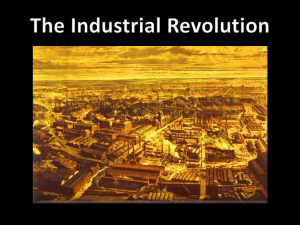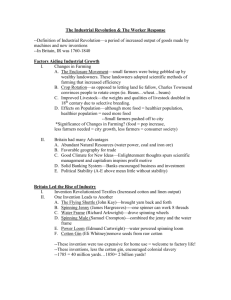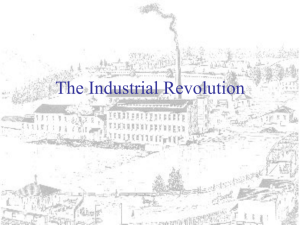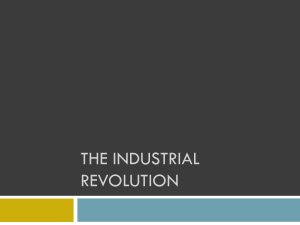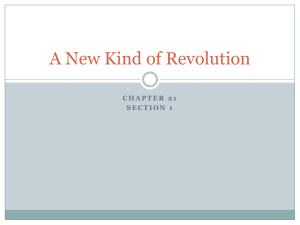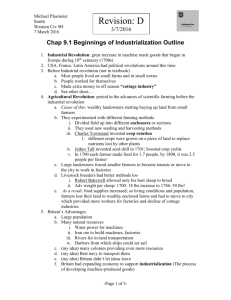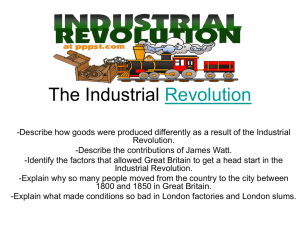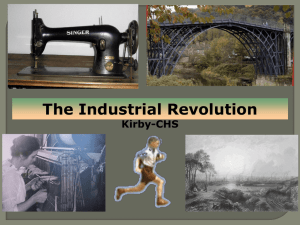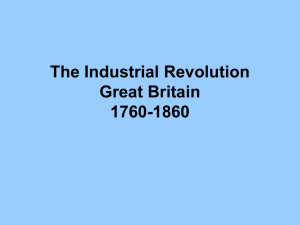PowerPoint Presentation - Coach Morgan World History Website
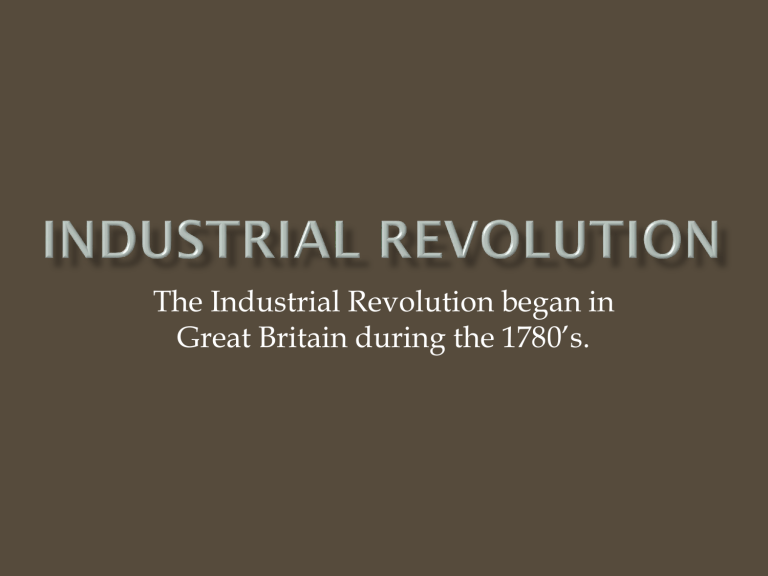
The Industrial Revolution began in
Great Britain during the 1780’s.
25% of people lived in towns & cities in the 1700s.
People used common lands jointly before 1600s.
After 1600s people began fencing off land called the Enclosure Movement.
Results
1) Large landowners forced small owners to become tenant farmers or move to the city.
2). Farmers could experiment with new methods of farming.
Jethero Tull: 1700s, Seed Drill ; Horse drawn cultivator ( remove weeds & break up soil)
Viscount Charles Townshend: Alternated different crops to preserve soil called Crop
Rotation.
Robert Ransome : Invented an iron plow in 3 parts.
1 st : Agricultural practices in the 18 th century had changed.
1). Expansion of farmland, good weather, improved transportation, & new crops, such as the potato, led to a dramatic increase in the food supply.
2 nd : With more abundant food supplies, the population grew.
1). Population increase created a large labor force to work in the new factories.
3 rd : Britain had a ready supply of money, or capital.
1). Capital was used for investing in the new industrial machines & the factories needed to house them.
4 th : Natural Resources were plentiful in Great
Britain.
1).
Rivers provided water power & a means for transporting raw materials and finished products from one place to another.
5 th : Supply of markets gave British manufacturers a ready outlet for their goods.
Great Britain surged ahead of everybody in the production of cotton goods during the 18 th century.
It was a 2 Step Process in the manufacturing of
cotton cloth.
1). Make the cotton thread from raw cotton.
2). Weavers wove the thread into cloth.
Cottage Industry: Task were done by individuals in rural homes.
Cotton was the 1 st textile industry to undergo mechanization.
1). Why? Domestic system could not meet the
demand for the use of cotton.
1764, James Hargreaves invented a spinning machine called the Spinning Jenny .
1787, Edmund Cartwright invented the water frame, a spinning driven by waterpower.
The cotton industry became more productive when the steam engine was improved in the
1760s .
Steam power could now be used to spin & weave cotton.
Steam Engine was crucial to Great Britain’s
Industrial Revolution.
Thomas Newcomen : (1712) English engineer produced the 1 st successful steam engine.
James Watt: (1769) Produced the modern steam engine.
Henry Cort: (1780s) Developed a process called
Puddling.
Puddling: Coke, which was derived from coal, was used to burn away impurities in crude iron, called pigiron, & produce an iron of high quality.
1804: The 1 st steam powered locomotive ran on an industrial rail line in Great Britain.
George Stephenson: (1814) Perfected a steampropelled moving engine, or locomotive, that ran on rails.
1). 1829: Stephenson’s locomotive, The Rocket , ran
29 mph.
Robert Fulton: Adapted the steam engine to ships, his boat the Clermont was launched on the
Hudson River in 1807 .
Great Western : (1838) A ship operated only by steam, crossed the Atlantic Ocean in 15 days.
Samuel Cunard : Founded the Cunard Line shipping company, provided regular steamboat services across the Atlantic Ocean.
Factory System: was organized method of production that brought workers & machines together under the control of managers .
Richard Arkwright: (1784) was the 1 st to bring workers & machines together in one place to make goods in his spinning mill.
What was the advantages of the Factory
System?
The Factory Act of 1819: Prohibited the employment of children under 9 years of age in cotton mills.
1833: These laws were applied to all factories.
1). Children between 9 & 13 could work 9 hours and 13-18 could work 12 hours per day .
1842: Another law prohibited the employment in mines of all women, girls, & boys under 10 .
Ten Hour Act: (1847) Established a 10 hour workday for women & children under the age of
18 in textile factories.
Great Britain became the world’s richest
industrial nation by the mid 19 th century.
The key to population growth were decline in death rates, wars, disease.
People who built factories, bought machines, & figure out where the markets were became the new Industrial Middle Class.
Capitalism: Economic system in which private individuals use money that is earned, saved, or invested to produce profits.
Industrial Capitalism: Economic system based industrial production.
Socialism: Is a system in which society, usually in the form of government, owns & controls some means of production such as factories and utilities .
(1771-1858) A British cotton manufacturer, was one utopian socialist.
Age 19 own his on mill in New Lanark ,
Scotland .
Built cooperative community in New
Harmony, Indiana.
Belief: Humans would show their natural goodness if they lived in a cooperative environment.

